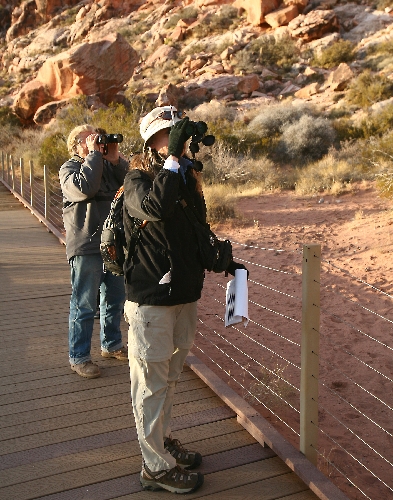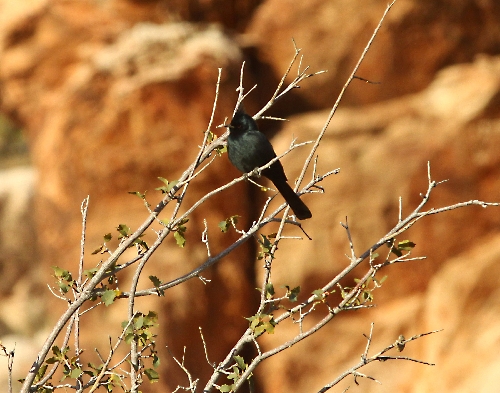Volunteers brave cold to count feathered friends for Audubon Society
The sun had not yet broken the night sky. The temperature hovered around freezing outside the Red Rock Canyon National Conservation Area Visitor Center Dec. 28.
Out of the dark came two dozen die-hard volunteers, bundled up in knit caps and winter coats. They entered the meeting room where they would get their assignments, then spend the rest of the day counting birds. It was all part of the National Audubon Society's Christmas Bird Count.
Jeanne Tinsman, management assistant for the Bureau of Land Management Red Rock/Sloan Field Office, hurried into the room and gave everyone a chipper welcome only to receive a murmured response. But she knew how to get their attention.
"We've got coffee and hot cocoa for you," she said, pointing to the back corner.
Caffeine fix completed, volunteers were split into groups of four or five and carpooled off to their designated areas. Tinsman led one to Cold Creek. Her group also would cover areas farther east where there are golf courses.
The Red Rock Canyon area is known for sightings of the Black Swift, the Grasshopper sparrow and the Mew gull. Phainopepla also were expected. They are one of the only birds that can eat and thrive on the highly poisonous mistletoe berries found in Red Rock Canyon.
Bird watching was also very much bird listening. Besides their calls, birds were identified by their coloring, shape and size and flight characteristics. Head shapes and bills also were key to putting a name to the feathered creatures. A clipboard held a list of 70 bird varieties. It was marked each time there was a sighting.
"I would love to see a Lawrence Goldfinch so I could fill out a rare bird report," Tinsman said.
Barbara Bergstrom has been a sporadic "birder" since the early 1970s. She lived all over the U.S. as well as Europe and Kenya. Each time, she learned the birds of her new home. Any rare birds?
"One time, I saw a snowy owl in Nebraska," she said.
Liz Carmer, a Summerlin resident, was in Belize when she reported seeing a pygmy owl.
"He'd been blown in by a storm," she said. "He was not supposed to be there."
Back in Red Rock Canyon, the bird's quick movement caught one's eye as a couple birds flitted in a tree. One bird landed on the trail to ensure that he was included in the tally.
"I've got a Rock Wren," called out North Las Vegas resident Bob Furtek.
Everybody hurried over to see. The clipboard received another check mark.
A swift bird shot past the red cliffs.
"It's either an American kestrel or a sharpie or a Merlin," Tinsman said as she tried to lock her binoculars on it. "Definitely not a falcon ... It's such a strong flier. It's got to be a Merlin."
Tinsman whipped out her National Geographic Field Guide to the Birds of North America and flipped to the right page to compare markings.
Furtek had his own book, dog-eared and with dated illustrations. He checked the copyright date: 1966.
"Over the years, some of the names have changed, so I just pencil them in," he said. "Look ---- the Merlin, this book calls it a 'pigeon hawk.' "
How did they know they wouldn't count a bird twice and throw off the count? It involved mentally noting where one bird flew to and whether it circled back, Tinsman said.
This day, however, there was no concern that any bird would be counted twice. The birds were refusing to venture out in the cold.
So Tinsman led the group to another area, deeper into Cold Creek. Frozen watering spots, she said, would force the birds to find open water. Maybe that would yield more sightings.
There were watering holes in shadow, covered with a thin sheet of ice. But there also were watering holes in the sun with no ice. Nice try.
Furtek tried to entice birds with chirps, hushing and kissy-kissy sounds.
"We need some raptors, big time," Carmer said, as she scanned the sky.
There was no competition among the birders. That would come later, when the groups met up again and compared totals.
"One group will go, 'We got 150 and you only got 30,' " Tinsman said.
Her group would not get bragging rights for high numbers. Three hours into the morning, only 15 kinds of birds had been sighted.
That was the way it went, sometimes, Tinsman said, and "why long-term data is so important."
The event was organized through the BLM. This was the 112th year for the bird count. Similar groups were forming in about six other locations of the valley, including Corn Creek, Henderson and the Muddy River area. More than 2,200 bird counts were taking place worldwide between Dec. 14 and Jan. 2. At the end of the day, 1,611 individuals of 63 species were identified by 24 participants.
The information is turned in to the Nevada Bird Records Committee, and results can be found at christmasbirdcount.org.
Contact Summerlin/Summerlin South View reporter Jan Hogan at jhogan@viewnews.com or 387-2949.























